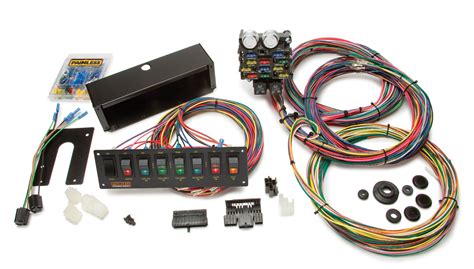Upgrade your race car's electrical system with our comprehensive wiring kit. Improve performance, reliability, and safety with our high-quality components and easy installation guide.

Race Car Wiring Kit: A Comprehensive Guide
Introduction:
In the world of motorsports, where speed, precision, and safety are paramount, the wiring system of a race car plays a crucial role. Unlike conventional vehicles, race cars demand a specialized wiring kit that can withstand extreme conditions, ensure optimal performance, and meet stringent safety regulations. This comprehensive guide delves into the intricacies of race car wiring kits, exploring their components, design considerations, installation procedures, and maintenance practices.
Understanding Race Car Wiring Kits:
A race car wiring kit is a specialized electrical system designed to meet the unique demands of competitive motorsports. It consists of an intricate network of wires, connectors, relays, and other components that work in unison to power the vehicle's essential systems, including the engine, ignition, fuel injection, lighting, and safety equipment. Unlike standard automotive wiring, race car wiring kits are engineered to withstand the rigors of intense racing conditions, such as high temperatures, vibrations, and potential impacts.
Key Components of a Race Car Wiring Kit:
A typical race car wiring kit comprises several vital components, each serving a specific function:
• Wiring Harness: The backbone of the wiring system, the wiring harness consists of a network of color-coded wires that connect various electrical components throughout the vehicle.
• Relays: These electromagnetic switches control the flow of electricity to high-power devices, such as the starter motor and fuel pump.
• Circuit Breakers: Designed to protect the electrical system from overloads, circuit breakers automatically interrupt the flow of current when an excessive amount of electricity is detected.
• Fuses: Similar to circuit breakers, fuses provide an additional layer of protection by melting and breaking the circuit if an electrical fault occurs.
• Connectors: These devices facilitate the connection and disconnection of various electrical components, allowing for easy maintenance and troubleshooting.
• Grounding System: The grounding system provides a common reference point for electrical circuits, ensuring proper functioning and preventing electrical noise.
Design Considerations for Race Car Wiring Kits:
The design of a race car wiring kit involves careful consideration of several key factors:
• Safety: The primary concern in race car wiring is safety. The kit must be designed to minimize the risk of electrical fires, shorts, and malfunctions that could endanger the driver and spectators.
• Reliability: In the fast-paced world of racing, reliability is paramount. The wiring kit must be able to withstand extreme conditions, vibrations, and potential impacts without compromising its functionality.
• Weight Reduction: Every ounce counts in a race car. The wiring kit should be designed to be as lightweight as possible without sacrificing performance or safety.
• Accessibility: For quick troubleshooting and repairs during races, the wiring kit should be designed with accessibility in mind, allowing easy access to critical components.
• Customization: Race cars come in various configurations and specifications. The wiring kit should be customizable to accommodate different engine types, electronic systems, and safety features.
Installation of Race Car Wiring Kits:
The installation of a race car wiring kit requires specialized knowledge and expertise. Here are the general steps involved:
• Preparation: Before beginning the installation, the vehicle should be thoroughly inspected, and any necessary modifications or repairs should be made.
• Wiring Harness Installation: The wiring harness is routed throughout the vehicle, following the manufacturer's instructions and ensuring proper connections to all electrical components.
• Component Installation: Relays, circuit breakers, fuses, and other components are installed in their designated locations, following the wiring diagram.
• Grounding System Installation: The grounding system is established using grounding straps and wires, ensuring a secure connection between the electrical system and the chassis.
• Final Checks: Once the installation is complete, all connections are thoroughly inspected, and a continuity test is performed to verify proper circuit integrity.
Maintenance and Troubleshooting of Race Car Wiring Kits:
Regular maintenance and troubleshooting are crucial to ensure the longevity and reliability of the race car wiring kit:
• Inspections: Periodic inspections should be conducted to identify any signs of damage, corrosion, or loose connections.
• Cleaning: The wiring kit should be cleaned regularly to remove dirt, debris, and moisture that can compromise its performance.
• Testing: Routine testing of the electrical system, including voltage checks and continuity tests, helps identify potential issues before they cause problems during races.
• Troubleshooting: In the event of an electrical issue, systematic troubleshooting is essential to pinpoint the root cause and implement appropriate repairs.
Conclusion:
A race car wiring kit is a critical component that plays a pivotal role in the performance, safety, and reliability of a race car. Understanding the components, design considerations, installation procedures, and maintenance practices is essential for ensuring optimal functionality and minimizing the risk of electrical failures.


